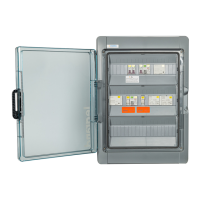18_06_07_Battery Backup Distribution_10010371_ENG_V1.8 Seite -25- von -38-
8. Phase coupling within Single-Phase „IPC“ version
In case of using the 1PH-Battery Backup Distribution „IPC“ (Inclusive of Phase Coupling), you
will get the opportunity for coupling the backup-phase L1 to the other ones:
L1 to L2 (circuit breaker “F3” activated)
L1 to L3 (circuit breaker “F4” activated)
L1 to L2 and L1 to L3 (circuit breaker “F3”+”F4” activated)
With the help of phase coupling, you are able to support the loads which are not connected
to the physical feed in backup-phase “L1”. Phase coupling will be activated by Sunny Island
controlled contactor “Q6”, if the main supply is in shutdown.
Destruction of 3-phase loads may occur during phase coupling!
Please connect Single-loads exclusively when phase coupling is activated!
• Only activate phase couplings for phases, whose power does not exceed the
maximum power of the Sunny Island!
• Working with the help of phase coupling, please label this functionality inside your
electrical distribution board! For this you will get a suitable warning sticker in the
Sunny Island’s scope of delivery!
• Electric stove: Every single stove is working as a single-phase load within the line
conductors "L1/L2/L3" and "Neutral". The backup functionality within phase coupling
does not create a 120° phase shift! The occurring current in the neutral-conductor of
the cable might get to high because of the missing phase shift! This could happen if
several stoves are working. Take suitable measures to ensure that the operation of an
electric stove is safe during the backup functionality (e.g. replacement of the 3-pole
circuit breaker by an all-pole circuit breaker)!
Naturally, if main’s supply recurs, contactor “Q6” is doing the disconnection of the phase
coupling.

